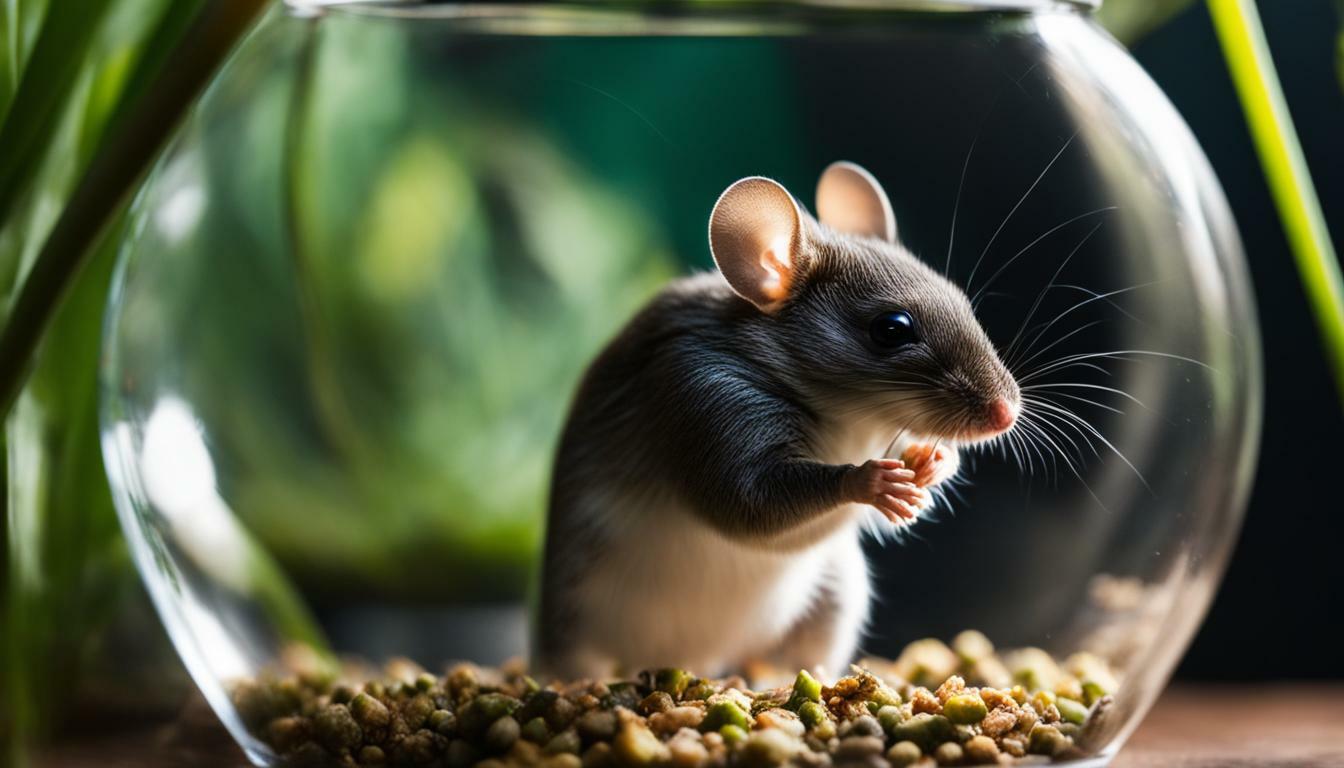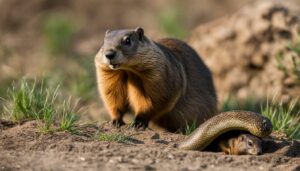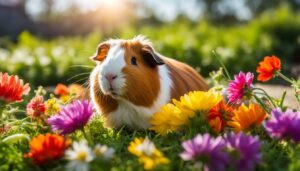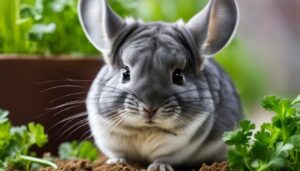If you’ve ever wondered if mice have crickets on their menu, you’re about to uncover the secrets of their dietary habits. Yes, mice do eat crickets. These tiny creatures are omnivores, meaning they will consume both plant and animal matter. This includes small insects like crickets, which are a potential food source for mice.
Mice are naturally attracted to crickets and other small insects. They have an opportunistic feeding behavior, meaning they will take advantage of any available meal. In addition to crickets, mice also consume other types of insects such as mealworms. They are always on the lookout for food wherever they can find it.
Aside from insects, mice have a varied diet that includes grains, fruits, and plant matter. However, it’s important to note that mice can cause damage to properties and spread diseases, making it necessary to control and prevent infestations of both mice and crickets.
To reduce the presence of mice and prevent cricket infestations, it is important to eliminate attractants. This can be achieved by removing sources of attraction for crickets, such as standing water, darkness, open trash, bright lights, and weeds. Sealing your home and storing food in rodent-proof containers are also crucial steps to prevent mice from accessing food sources.
Key Takeaways:
- Mice are omnivores and will eat both plant and animal matter, including crickets.
- They are attracted to crickets and other small insects as a food source.
- Mice are opportunistic feeders and will consume mealworms and other types of insects.
- In addition to insects, mice also eat grains, fruits, and plant matter.
- Controlling and preventing infestations of mice and crickets is important to avoid property damage and disease transmission.
Mice as Omnivores
Mice, being omnivores, have a diverse diet that includes both plant and animal matter, making them open to enjoying a wide range of meals. Their opportunistic feeding behavior allows them to take advantage of various food sources, including small insects like crickets.
These little critters are attracted to crickets and other small insects as a potential food source. Their keen sense of smell and ability to squeeze into tight spaces make it easy for them to find and capture their prey.
In addition to crickets, mice also consume other types of insects such as mealworms. Their adaptable nature allows them to feed on whatever is available, be it grains, fruits, or plant matter. This flexibility in their dietary preferences ensures that they can survive in a variety of environments.
Mice and their Dietary Preferences
While mice do eat crickets and other insects, it’s important to note that they are not solely dependent on them for sustenance. They are known to scavenge and forage for a wide range of food items, making them highly adaptable to their surroundings.
Controlling the presence of mice and crickets is essential, as they can cause significant damage to property and potentially spread diseases. Eliminating attractants such as standing water, open trash, and access to food sources can help reduce infestations. Sealing the home and storing food in rodent-proof containers are additional preventive measures that can deter mice from entering and accessing food supplies.
| Dietary Habits of Mice | Examples |
|---|---|
| Insects | Crickets, mealworms |
| Plant Matter | Grains, fruits, vegetables |
| Other | Scavenged food, leftovers |
By understanding the dietary preferences and habits of mice, we can take the necessary steps to prevent and control infestations. Keeping our living spaces clean, eliminating attractants, and implementing effective pest control measures can help ensure a mouse-free environment.
Crickets as a Food Source for Mice
Crickets have a special place on the menu for mice, as these small insects serve as a delectable food source that can attract mice to a property. Mice, being omnivores, have a varied diet that includes both plant and animal matter. They are opportunistic feeders and will take a meal wherever they can find it. This includes devouring crickets and other types of insects like mealworms.
It is important to note that the presence of crickets can also invite mice into your home or property. These rodents are naturally attracted to the scent of the crickets, especially if they are searching for a readily available food source. Therefore, if you have a cricket infestation, it is crucial to take action to prevent mice from entering as well.
To reduce the likelihood of attracting mice with crickets, it is recommended to eliminate sources of attraction for crickets. This includes reducing standing water and excessive darkness, as crickets are drawn to moisture and prefer dark hiding places. Additionally, keeping trash containers securely closed, minimizing bright lights near entry points, and regularly maintaining your yard to control weeds can help deter both crickets and mice from your property.
| Crickets as a Food Source for Mice: |
|---|
| Mice are omnivores and will consume both plant and animal matter. |
| Mice are attracted to crickets and other small insects as a food source. |
| Crickets can also attract mice to a property. |
| Mice will eat crickets, mealworms, and other types of insects. |
- Eliminate sources of attraction for crickets, such as standing water, darkness, open trash, bright lights, and weeds.
- Regularly maintain your yard to control weed growth.
- Keep trash containers securely closed.
- Seal entry points to your home to prevent mice from accessing food sources.
Other Insects Mice Consume
Alongside crickets, mice also have a taste for various insects, including mealworms and other small critters that cross their path. As opportunistic feeders, mice will consume any available food source, and insects are no exception. These tiny creatures provide a source of protein and nutrients that mice need to thrive.
It’s not just crickets that can attract mice to your property; other insects like mealworms can also entice these rodents. Mice are skilled hunters and will actively seek out these small, wriggling creatures as a potential meal. Their agile nature allows them to catch and devour insects with ease.
When it comes to controlling and preventing infestations, it’s crucial to consider the full range of insects that mice consume. By eliminating attractants for these creatures, such as standing water, open trash, and bright lights, you can reduce the presence of both crickets and mice. Additionally, storing food in rodent-proof containers and sealing any entry points into your home will help deter mice from accessing their desired food sources.
| Insects Mice Consume | Benefits for Mice |
|---|---|
| Crickets | Source of protein and nutrients |
| Mealworms | Rich in essential nutrients |
| Other small critters | Varied nutritional content |
Mice and Their Dietary Preferences
While mice enjoy feasting on insects, their dietary preferences extend beyond that, with grains, fruits, and plant matter serving as equally appealing options. Mice are omnivores, meaning they have a wide-ranging diet that includes both plant and animal food sources. This adaptability allows them to thrive in a variety of environments, including urban areas where they often come into contact with humans.
When it comes to grains, mice have a particular fondness for seeds, cereals, and other starchy foods. They are attracted to the rich source of carbohydrates that grains provide, making your pantry an enticing target. Fruits, both fresh and dried, are also on the menu for these little rodents. Be wary of leaving out leftover fruit or sugary snacks, as mice are known to have a sweet tooth.
Plant matter such as leaves, stems, and roots can also make up a substantial portion of a mouse’s diet. They are opportunistic feeders and will nibble on vegetation they come across. This can pose a problem for gardeners and farmers, as mice may damage crops and ornamental plants.
| Foods Mice Eat | Foods Mice Avoid |
|---|---|
| Grains (seeds, cereals) | Spicy foods |
| Fruits (fresh, dried) | Bitter foods |
| Plant matter (leaves, stems, roots) | Sour foods |
| Insects (crickets, mealworms) | Strong-smelling foods |
It’s essential to understand the dietary preferences of mice to effectively deter them and prevent infestations. By eliminating food sources and implementing proper storage practices, you can minimize the risk of attracting mice to your property. Seal any gaps or holes in your home and store food in rodent-proof containers to keep these opportunistic feeders at bay.
Preventing Mice and Cricket Infestations
To keep your home free from unwanted visitors like mice and crickets, it’s essential to eliminate the factors that attract them and take proactive measures to secure your space. By implementing the following preventive measures, you can greatly reduce the chances of infestations and maintain a pest-free environment:
1. Eliminate Attractants for Crickets
- Remove standing water sources, as crickets are attracted to moist environments.
- Keep your home well-lit, as crickets are less likely to thrive in bright areas.
- Seal cracks and gaps in doors, windows, and foundations to prevent crickets from entering your home.
- Maintain a tidy outdoor space, regularly clearing away debris and trim vegetation to reduce hiding spots for crickets.
2. Seal Your Home against Mice
- Inspect your home for any openings or gaps that mice can use to enter and seal them immediately.
- Pay attention to areas such as windows, doors, foundation gaps, utility openings, and vents.
- Repair damaged screens or vents to prevent mice from gaining access.
- Store firewood, clutter, and other materials away from the perimeter of your home to eliminate potential nesting areas for mice.
3. Proper Food Storage
Mice are attracted to readily available food sources, so it’s crucial to store food in rodent-proof containers:
| Storage Tips | Benefit |
|---|---|
| Use airtight containers | Prevents mice from detecting and accessing food sources |
| Keep food stored in high cabinets or on shelves | Makes it difficult for mice to reach food |
| Regularly clean up spills and crumbs | Reduces food debris that attracts mice |
By following these preventive measures and maintaining a clean, well-protected home, you can greatly reduce the chances of mice and cricket infestations. Remember, early detection and swift action are key to effectively controlling these pests and keeping your home pest-free.
Controlling Mice and Cricket Populations
By taking control of mice and cricket populations, you can minimize the risk of infestations, keeping your property safe and free from the potential damage and diseases they may bring. To reduce the presence of mice and prevent infestations, it is important to eliminate attractants for crickets and implement proper preventive measures.
Preventive Measures
- Eliminate standing water: Crickets are attracted to moist environments, so be sure to fix any leaks or remove stagnant water sources around your property.
- Reduce darkness: Crickets thrive in dark areas, so keep your property well-lit to deter them from taking up residence.
- Dispose of open trash properly: Crickets are attracted to food sources, so seal your trash cans tightly and keep them clean to avoid attracting them.
- Manage outdoor lighting: Bright lights can attract crickets, so consider using yellow or sodium vapor lights that are less attractive to insects.
- Maintain landscaping: Weeds and overgrown vegetation provide hiding spots for crickets, so keep your yard well-maintained and remove any potential hiding places.
Sealing Your Home
To prevent mice from accessing your home and food sources, it is essential to seal any potential entry points. Here are some tips:
- Inspect your property: Look for gaps or cracks in your walls, foundation, doors, and windows, and seal them using caulk or weatherstripping.
- Fix damaged screens: Repair any holes or tears in window screens to prevent mice from entering through open windows.
- Seal utility entrances: Ensure that openings around pipes, vents, and utility lines are properly sealed to prevent mice from using them as entry points.
- Store food properly: Keep food stored in rodent-proof containers, such as glass or metal containers with tightly sealed lids.
By following these preventive measures and sealing your home against mice, you can significantly reduce the risk of infestations and create an environment that is less attractive to both mice and crickets. Taking proactive steps to control their populations will help keep your property safe, preventing potential damage and the spread of diseases that these pests may carry.
| Preventive Measures | Sealing Your Home |
|---|---|
| Eliminate standing water | Inspect your property |
| Reduce darkness | Fix damaged screens |
| Dispose of open trash properly | Seal utility entrances |
| Manage outdoor lighting | Store food properly |
| Maintain landscaping |
Conclusion
In conclusion, mice do have crickets on their menu, but their dietary habits extend beyond insects, making it crucial to prevent and control infestations to maintain a peaceful and hygienic living environment.
Mice are omnivores and will consume both plant and animal matter, including small insects like crickets. They are attracted to crickets and other small insects as a potential food source. This attraction can lead to infestations if not properly controlled.
However, mice do not only eat crickets. They are opportunistic feeders and will consume a variety of foods, including other types of insects like mealworms. In addition, mice will also eat grains, fruits, and plant matter. Their diverse diet allows them to survive and thrive in various environments.
Controlling and preventing infestations of both mice and crickets is important for several reasons. Mice can cause property damage and spread diseases, posing risks to both humans and pets. Crickets, on the other hand, can create noise and become a nuisance. By eliminating sources of attraction for crickets, such as standing water, open trash, and bright lights, it can help reduce the presence of mice as well.
To prevent mice infestations, it is important to seal the home and store food in rodent-proof containers. This will prevent mice from accessing food sources and reduce their presence in the living environment. By implementing proper preventive measures and seeking professional assistance if needed, homeowners can maintain a peaceful and hygienic living space, free from mice and cricket infestations.
FAQ
Do mice eat crickets?
Yes, mice are omnivores and will consume both plant and animal matter, including small insects like crickets.
What other insects do mice eat?
In addition to crickets, mice also eat mealworms and other types of insects. They are opportunistic feeders and will take a meal wherever they can find it.
What else do mice eat besides insects?
Mice also eat grains, fruit, and plant matter as part of their diet.
How can I prevent mice and cricket infestations?
To prevent infestations, it is important to eliminate sources of attraction for crickets, such as standing water, darkness, open trash, bright lights, and weeds. It is also crucial to seal the home and store food in rodent-proof containers to prevent mice from accessing food sources.
Why is it important to control mice and cricket populations?
Mice can cause property damage and spread diseases, while crickets can attract mice to a property. Controlling both populations helps maintain a safe and sanitary living environment.




